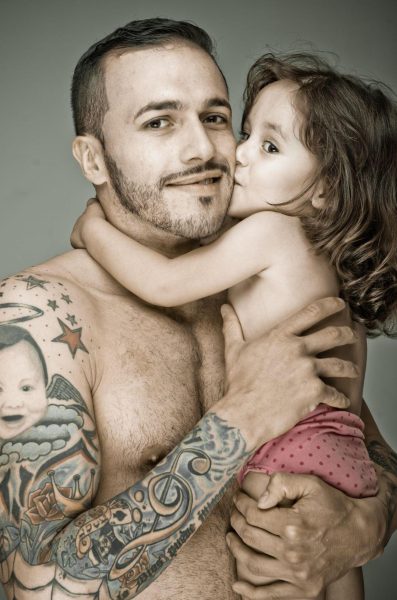There’s an age-old adage that says, “A picture is worth a thousand words.” Now, imagine that picture etched onto your skin, holding lots of emotions, stories, and experiences. For many of us, tattoos aren’t just about the ink; they’re about the tales they tell and the journeys they memorialize. Portrait tattoos, in particular, have a profound way of capturing moments, freezing them in time – giving both wearer and observer a snapshot of a memory that means the world.
We’ve all heard the casual conversations: “What’s the story behind your tattoo?” or “Why did you choose to ink that?” And truthfully, it’s never a simple answer, is it? For every drop of ink, there’s a reservoir of emotions, a sea of memories. Whether it’s the beaming face of a child born against all odds, the loving wrinkles of a grandmother who taught you life’s greatest lessons, or even a self-portrait, marking a milestone or a transformation – these tattoos are so much more than skin deep.
But why have portrait tattoos surged in popularity over the years? What’s the pull about, and why do people from all walks of life find solace in inking their moments?
The Historical Connection
There was a time when our ancestors sat around campfires, the air thick with stories, hopes, and aspirations. It’s fascinating to think that even then, long before the sophisticated ink guns we see today, humans had an innate desire to express themselves through the art of tattoos. And no, it wasn’t just about adorning their bodies or following a trend. It was symbolic, deeply personal, and sometimes even spiritual.
Tattoos Were More Than Just Tribal Markings
Ancient tribes across different continents used tattoos as rites of passage, marks of status, or even as protective charms. In some cultures, a tattoo signified a warrior’s courage in battle, while in others, it was a sacred seal to ward off evil spirits. The Maori of New Zealand, for instance, had their famous moko designs. These weren’t mere decorations; they were personal insignias that told stories of ancestry and personal achievements. Every single line, dot, or swirl had a tale to tell.
However, with time, as civilizations grew and cultures intermingled, the purpose of tattoos began to evolve. From tribal markings, they shifted to become memorials of loved ones, symbols of rebellions, or even tokens of love. Sailors in the 18th century, journeying to distant lands, would often get tattoos as souvenirs from the exotic places they visited or as a homage to the sea, their eternal companion.
The Artistic Evolution from Symbols to Stories
Fast forward to today, and you’ll notice how the art of tattooing has magnificently transformed. Gone are the days of simplistic designs or rudimentary symbols. Now, it’s the era of portrait tattoos – a true testament to the artist’s skill and the bearer’s personal story. But when did this shift happen?
The last few decades have seen a significant surge in the demand for portrait tattoos. While earlier tattoos were more symbolic, today’s tattoos narrate stories, capture emotions, and even challenge the boundaries of art. The likeness these tattoos bear to actual photographs or paintings is nothing short of miraculous. And it’s not just about replicating a face; it’s about capturing the essence, the soul. It’s about breathing life onto the skin.
Father with a Portrait Tattoo

It’s not just about inking a face; it’s about capturing a lifetime of memories. And when the artist succeeds in doing that, when every smile line, every freckle is just where it’s supposed to be, the outcome is heart-stirringly beautiful.
The Craftsmanship behind Portrait Tattoos
The whir of a tattoo machine often brings with it a rush of adrenaline for those eager to transform a cherished memory into a permanent work of art. But behind the machine and every precise needle movement is an artist with a story, passion, and unparalleled skill.
In a recent intimate chat with renowned tattoo artist Lin, famed for her realism tattoo, she shed light on the layers beneath the surface. “Every portrait tattoo is a dance,” Mia expressed with fervor in her eyes. “The ink, the skin, the artist, and the story all sway to the rhythm of that one moment being captured.” To many, the process might seem straightforward—like transferring an image onto the skin. But Lin chuckles at this notion, “It’s about capturing souls, not just images.”
She’s not alone in this sentiment. The world of realism tattoos is brimming with artists who spend countless hours perfecting their craft. For them, it’s not merely about replicating a photograph; it’s about breathing life into it on a canvas that’s so incredibly personal.
In the Details Lies the Truth
For many, it’s the minutiae that matter. Remember the soft dimple that played on your mother’s cheek when she smiled? Or the deep-set wrinkles that marked your grandfather’s forehead, each one a testament to his wisdom? How about that distinct birthmark that you and your sibling shared, a testament to your unique bond? These aren’t just features; they are stories, encapsulated memories that demand precision and devotion.
That’s the essence of portrait tattoos. It’s more than just inking a portrait. It’s about recreating textures, giving depth to those dimples, shadowing those wrinkles just right, and ensuring the birthmark stands out, just as it should. These details are what turn a tattoo from a mere image into a lifelike memory.
To the untrained eye, these might seem like small elements. But to the person wearing the tattoo and to the artist who inked it, they’re the world. And yes, while the world of tattooing is vast and diverse, the dedication to detail in this specific genre is unparalleled.
Trust and Responsibility in Portrait Inking
Let’s imagine this scenario: You’re at a renowned tattoo studio, gazing at a photograph of your beloved grandmother. The twinkle in her eyes, the laugh lines tracing the corners of her mouth, the delicate curve of her cheekbone – every detail is precious. Now, you’re handing this cherished image to a tattoo artist, with the hope and trust that they will recreate not just her face but her essence on your skin.
At this moment, the trust between you and the artist is paramount. A survey by Tattoo Chronicles found that over 85% of individuals believe that their bond with their tattoo artist was as crucial as the design itself when it came to portrait tattoos. This isn’t surprising. A tattoo portrait is not merely about inking an image, but about capturing a memory, an emotion, and a story.
From the artist’s perspective, it’s an honor and a challenge. Indeed, for tattoo artists, every stroke, every shade, every tiny detail matters immensely. It’s not just about getting the face right; it’s about immortalizing a soul, a feeling, a fleeting moment in time.
While apprehensions are natural, the beauty of a well-done tattoo portrait lies in the balance between the trust of the individual and the responsibility of the artist.
Beyond the Aesthetic Appeal of Portrait Tattoos
At a casual glance, it’s easy to marvel at the sheer artistry of portrait tattoo designs. The detailed features, the play of light and shadow, and the lifelike representation— they’re captivating to say the least. But like any masterpiece, there’s more than what meets the eye. Dive a little deeper, and you’ll find layers of stories, emotions, and memories intricately woven into every stroke of ink.
It’s a Timeless Evolution with Our Growth
Here’s something to mull over: As we age, so do our tattoos. But rather than seeing this as a downside, many embrace it as a beautiful testament to the passage of time. Dr. Lisa Walker, a renowned dermatologist and tattoo lover herself, notes, “As our skin changes, so does the ink embedded within. Portrait tattoos evolve, not fade. They grow, age, and transform just as we do.”
It’s a beautiful dance of nature and art. The little girl’s face on a mother’s back grows up, the wrinkles deepening, making the portrait even more meaningful. The self-portrait of a 25-year-old on a now 50-year-old’s arm stands as a testament to growth, maturity, and the ever-changing nature of life.
Tips for Those Considering Tattooing Portraits
We all have that one friend who’s a natural with a pencil or paintbrush, right? But tattooing portraits? That’s an art form of a different kind, one that requires not only talent but also dedication, expertise, and a deep understanding of the human canvas.
So, when you’re about to etch a moment of your life permanently onto your skin, the artist you choose becomes the storyteller of your tale. Look for artists who specialize in portrait tattoos. Check into their portfolios and the details of their past works. Notice the finesse in the strokes, the shading techniques, and even how they capture emotions. A tattoo artist’s previous works can often speak louder than any review or rating. Remember, a great landscape artist might not necessarily excel at capturing the essence of a human portrait. Specialization is key.
The Prep Work
Imagine you’re about to paint a masterpiece. Would you just slap some paint onto a dirty, crumpled canvas? Definitely not! Similarly, before tattooing portraits, ensuring your skin is in its best condition is crucial. Here’s how:
- Image Selection: Opt for high-resolution images. The clearer the reference, the better the outcome. It helps the artist discern even the subtlest details.
- Skin Prep: Hydration is key! Drink ample water in the days leading up to your appointment, and moisturize your skin regularly. Well-hydrated skin tends to take ink better.
- Avoid Sunburns: Sunburnt or overly tanned skin can be problematic. Not only is it painful, but it can also affect the tattoo’s healing process.
Ensuring the Longevity of Your Portrait Tattoo
A tattoo, especially one as detailed and intricate as a portrait, is an investment in yourself. But the journey doesn’t end when you walk out of the studio; it’s only the beginning. Aftercare is crucial, and while there are many well-known care routines, let’s dive into some lesser-known, but equally crucial, secrets:
- Avoid Direct Sunlight: While this might seem obvious immediately after getting inked, it’s a long-term commitment. Over time, direct sunlight can cause the colors to fade, especially on detailed portraits. Investing in a good sunscreen can keep those memories vibrant.
- Gentle Moisturizing: While heavy lotions can clog pores and affect healing, lightweight, non-scented moisturizers can keep the skin supple and help maintain the tattoo’s vibrancy.
- Avoid Immersion: Quick showers are alright, but avoid soaking your tattoo in water (like in bathtubs or swimming pools) for prolonged periods during the initial healing phase.
As someone who’s felt the buzz of the tattoo machine and the thrill of seeing a memory come alive on my arm, I can attest to the transformational journey of tattooing portraits. It’s not just about the pain or the ink; it’s about the stories we choose to wear with pride.





